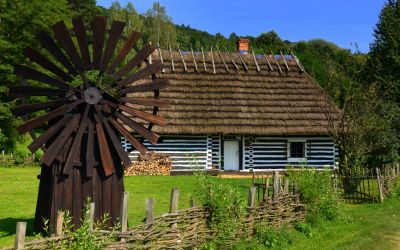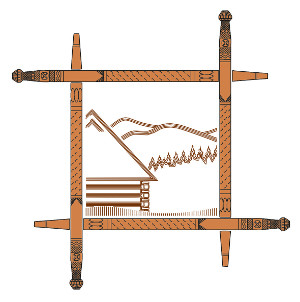
One of the most original crafts associated with the mountains in the area of our interest is the production of crags, hardnuts, ladders, silylines and other bead decorations. The most effective work is krywulka - a characteristic jewelry for the Lemko region of Komanka. In Komańcza, rich maidens wore special, colorful, patterned ornaments that they wore around the neck and shoulders like a collar. Their size and color testified to the wealth of the virgin. They were made of small beads the size of a poppy seed. Necklaces could be made by threading beads into threads of one to ten. The pattern was built thanks to appropriate crossing and threading, which resulted in a grid structure, as well as cross and circular patterns. Lemkos were made with a needle or on specially used looms. In the Bojkowszczyzna, there were no extensive crags, but much more modest hardans (in the form of a pendant), or a neck band made of beads alone or with a selvedge or embroidered band.
Currently, such products are manufactured in the Bieszczady Mountains, mainly for the tourist market. Among them, priority is given to Mrs. Daria Boiwka, who, together with her late husband Stefan, created a private Lemko museum in Komańcza, where, in addition to original exhibits, they produced magnificent krywulki and Lemko jewelry, and also cultivated the Lemko embroidery - including the tradition of embroidered icons. Another person in the region is Ewelina Matusiak-Wyderka, who runs the Miodosytnia art studio. It deals with the production and sale of bead jewelry; traditional - ethnic) and contemporary, inspired by old patterns. He also runs craft workshops and multimedia-sensory presentations on handicrafts. Currently, more and more people are undertaking this craft in the region. Krywulki, but also other examples of regional crafts and art, can also be admired at the Folk University in Wola Sękowa.
After organizing a few years ago by Roman Glapiak at the Agrogusiness "U Flik" in Dźwiniacz near Ustrzyki Dolne, workshops for performing thrombites, which were carried out by members - thrombiters from a folk group, from Bojkowska Bitla, close to the Polish border, also this craft is beginning to spread. The process of performing thrombity has been described in the chapter devoted to music and instruments from the Boyko region, as well as the method of performing sopilka.
The embroidery of this part of the Carpathians is characteristic. Very rich and eye-catching, they are the decoration of women's and men's blouses, shirts, dresses, table runners, napkins, tablecloths, jealousies etc. Bieszczady embroidery of the Eastern Lemko region, and in particular of the Boyko region, are wonderful, archaic, geometric patterns containing pre-Christian symbolism, assimilated by the new religion to so much so that the majority of society no longer knows their meaning despite using them. Similarly, this is the case in architecture, which is decorated with solar rosettes, sickle-shaped rosettes and other pawukas (spiders), comman peacock feathers (ferns), trees of life, etc.
Currently, the Bieszczady Mountains are experiencing a renaissance of regional embroidery and geometric decorations inspired by the culture of these mountains, which can be seen more and more in public space. In addition to embroidery and architecture, such motifs are used more and more in souvenirs. In painted decorations and even prints on bags, T-shirts etc.
In developing wooden architecture styling inspired by the style of the Boyko region, an excellent artist from Bieszczady specializes in, and at the same time, an employee of the Museum of Folk Architecture in Sanok.
One of the most interesting local initiatives is the "Czumak" gallery of Daria and Tomasz Kośków, who offer handicrafts and souvenir products made in the Eastern Carpathians, from the Bieszczady Mountains, through Ukraine, Slovakia to Romania. Here you will find original products made of: wood, wool, fabrics, ceramics, icons, paintings, jewelry and decorations with 100% Carpathian pedigree. https://czumak.pl
Extremely interesting ceramics, inspired mainly by squat ceramics (the largest collections in the Historical Museum in Sanok) are made by Izabela Ziomek from Wola Sękowa in the commune of Bukowsko. Particularly valuable are tiles made using the traditional method, decorated with rustic motifs and figural representations.
Traditional professions can be learned and learned at the "Bieszczady School of Crafts, in Uherce Mineralne, run by distinguished cultural animators from Bieszczady: Marzena and Janusz Demkowicz.
The unique stained glass and decorations made of glass set in metal are made incomparably by Zofia Paterek from Sanok. Bojkinie and Bojków wore similar decorations, especially in the form of cufflinks.
It is worth quoting yet another interesting initiative that Roman Glapiak carried out at his agritourism farm in Dźwiniacz near Ustrzyki Dolne. He organized several times artistic drilling workshops, derived from the old tradition of wire braiding of clay pots. Since the demand for such services will disappear in the Carpathians with the spread of cheap metal pots, some of the tinkers found a new niche for themselves, making from braided, thin wire, sometimes connected with glass, ceramics and even precious stones, original, dishes, baskets, decorations, jewelry and souvenirs. This tradition survived in only a few places of the Slovak Carpathians. Thanks to the initiative of Roman Glapiak he returns triumphantly to the Polish Bieszczady Mountains.
Bieszczady cultural space still has many inspirations. However, due to the war-ethnic turmoil described earlier, they require rediscovery, development, and description in popularization, which the author of these words has been doing for years.














